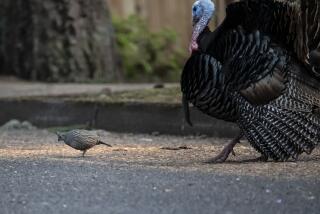‘Raven Rick’ and his flock are at home with each other at Crystal Cove
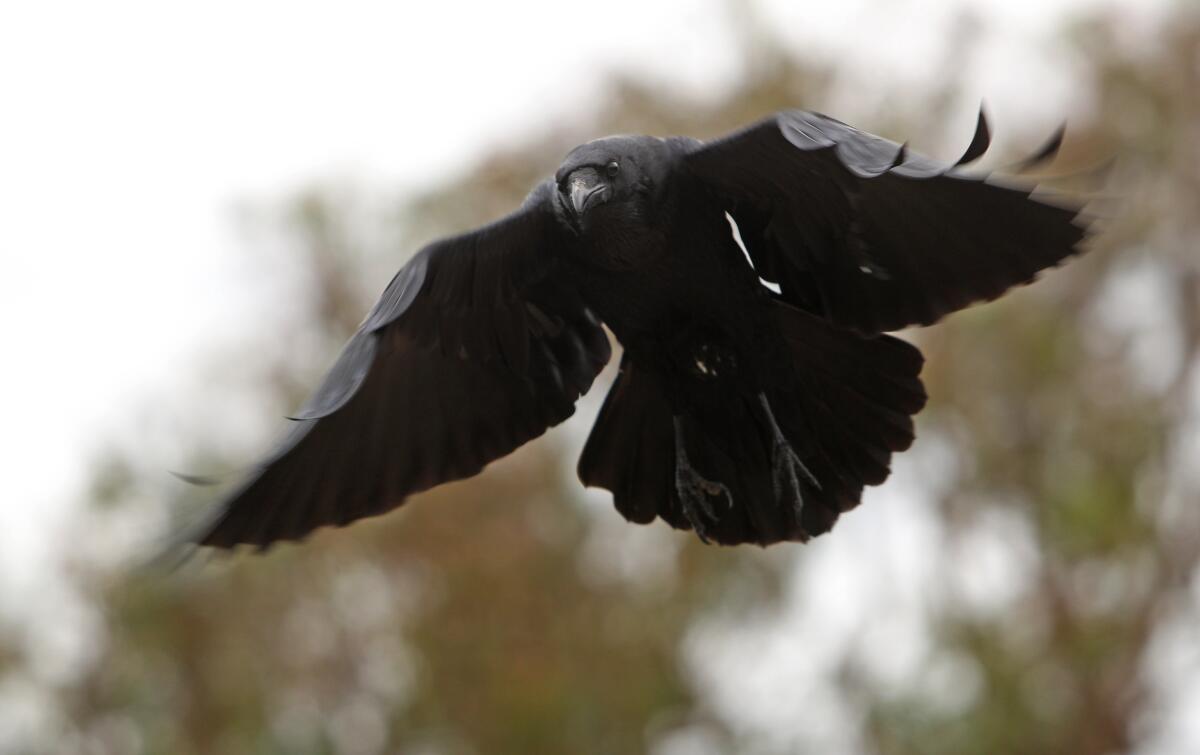
- Share via
The enchanted season is approaching at Crystal Cove State Park.
It’s the time when the ravens learn to fly.
Rick Boufford has watched brood after brood of common ravens tended closely by “his” birds, the ones he has called Gus and Lisa, Harold and Maude, Mr. and Mrs. Moro, Edgar and Lenore, the Pips and the Jets over the last 20 years.
Clever, emotive, athletic, inquisitive and brimming with mystique, ravens are territorial and nonmigratory and form deep pair bonds, allowing bird fanciers like Boufford to study the same birds for years. He’s not a formally trained expert, but he knows their quirks. They know his. He walks beneath them. They glide above him, loosely tracking.
After decades of quiet, patient study a short drive from his Newport Beach home, the lay ornithologist with the nickname “Raven Rick” has gotten physically close enough to the resident specimens to spot differences — a misshapen foot, an unpigmented patch, a hooked bill — and differentiate characteristics that direct their behavior, allowing him to recognize them at any distance.
His observations tell him that eggs will appear around March and hatch in about three weeks. Ravens fledge at about five to six weeks and test their developing wings with midflight tuck and rolls.
“It’s like an air show,” Boufford said. “It’s magical.”
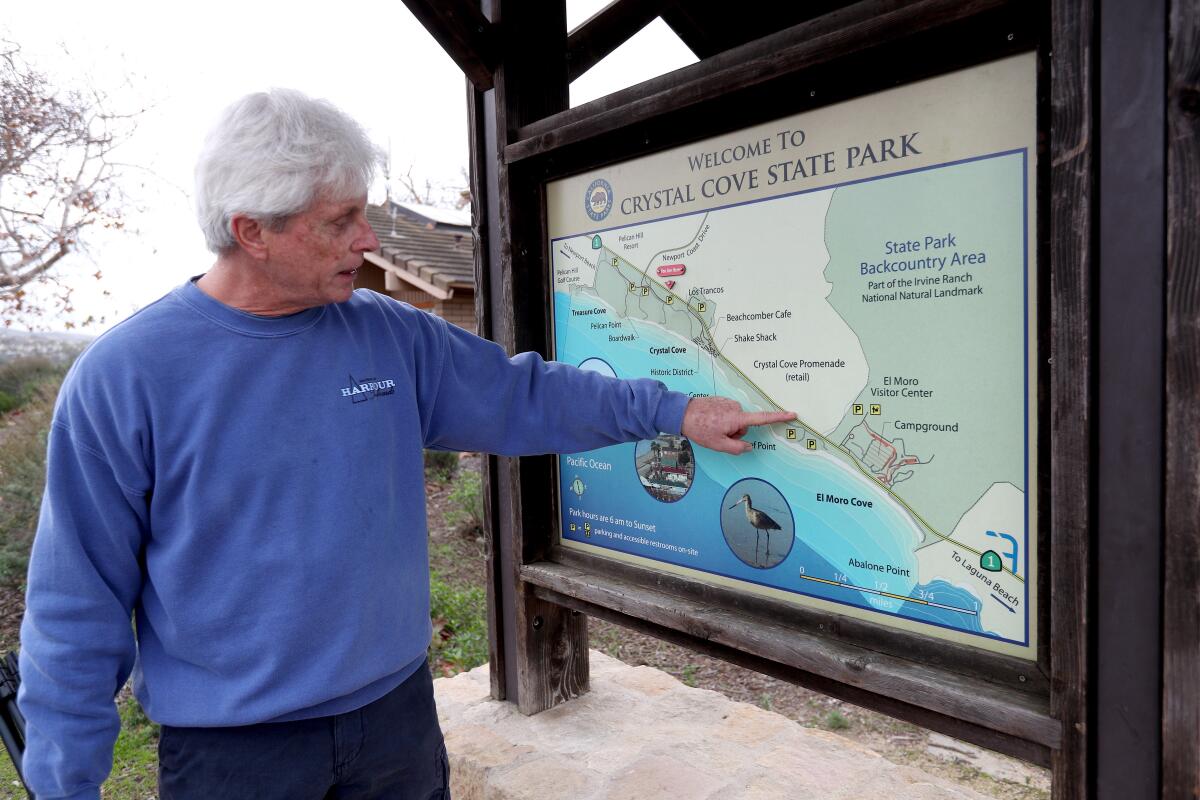
Professionally, Boufford is a restaurateur and sommelier. He seeks out ravens when he travels, makes short raven films — his YouTube channel, The Raven Diaries, has more than 21,000 subscribers — and is a tinkerer. The Crystal Cove Conservancy keeps him on its roster of volunteers to offer weekly classes in making jewelry with sea glass collected under the bluffs where the ravens nest.
“I’m just king of the goof-offs is all,” he said breezily. “I like to play. Life’s meant to play”
Boufford, 63, grew up in the Pasadena area but often visited Newport Beach to join cruises on the family boat to Catalina Island. He knew from age 5 that the sea made him sick, but he entertained a boyhood dream of being a chef on the Calypso, the famed research vessel of oceanographer Jacques Cousteau.
After high school he moved south for the cleaner air and to take courses in Orange Coast College’s marine science program. He left before graduation to purse his other dream vocation, cooking. His career ranged from the Rusty Pelican in Newport to Black Sheep, a Mediterranean fusion eatery that he and his wife owned in Tustin. He now leads in-home participatory dinner parties.
He went to Crystal Cove about 20 years ago to gather footage for a documentary he wanted to make after a raven he had rescued rejoined the wild. He wanted to know if the Crystal Cove ravens would be different.
“I had seen them dancing in the thermals off here,” he said.
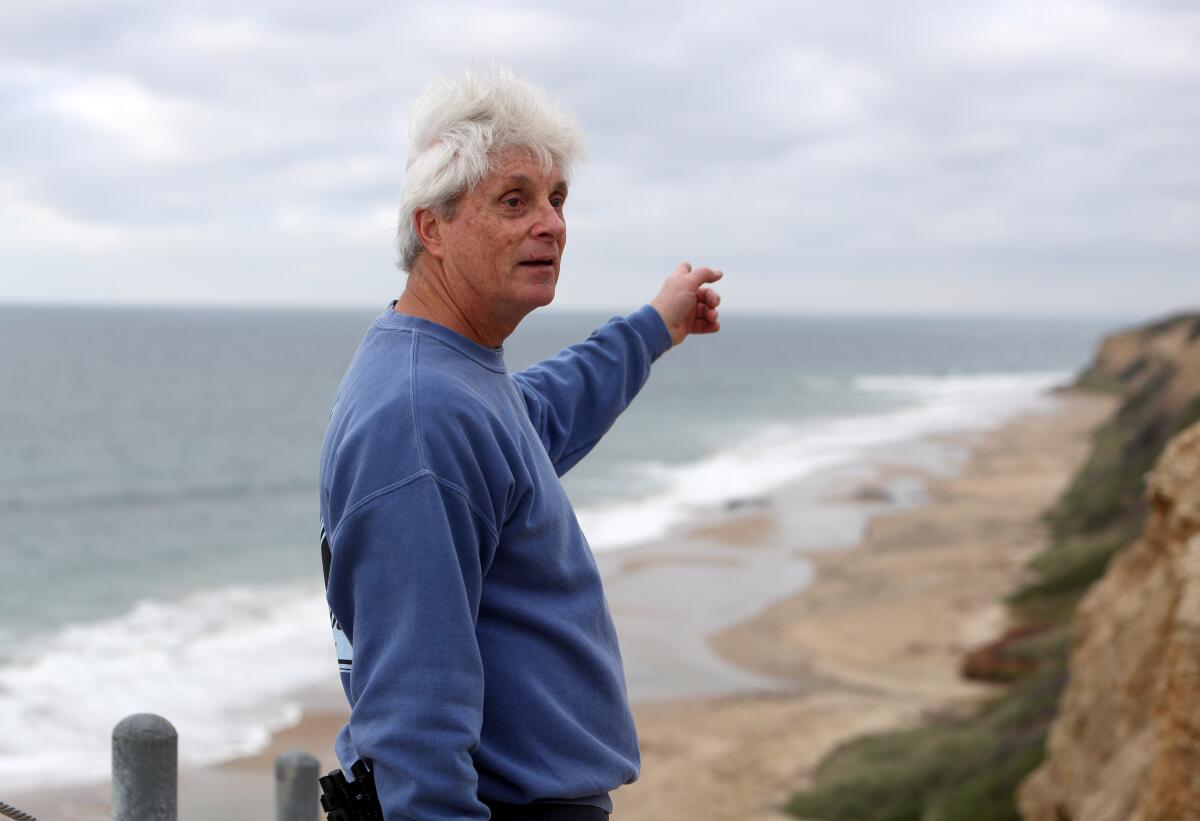
Boufford’s father was a forest ranger who taught him to toss roadkill off the pavement to keep coyotes and other scavengers from getting hit by cars.
That’s how Boufford got the attention of the ravens, which will eat dead animals. They filed his face away as their waiter and decided he was trustworthy, he said.
A raven is “a little bit like a cat, a little bit like a dog and a lot like an owl,” Boufford said. They’re acrobatic. They’re playful and can fetch. They have presence.
About 10 years ago, he recorded six couples along the 4-mile Crystal Cove beachfront. Now there are only three, he said, drawing his finger along a map in a kiosk at Parking Lot 4, across the Coast Highway from Newport Coast Drive. Interlopers are chased off.
He takes a morning walk every Wednesday from the ramp below Lot 4 to the Shake Shack, looking down for sea glass and up for ravens. Then he gets his usual breakfast burrito and watches the birds some more before his jewelry class.
The birds are especially energetic in the morning.
“They’re excited for the day,” Boufford said.
They also have business to attend to.
Maude disappeared three years ago, leaving her mate, Harold, to raise a brood solo. Harold eventually took a new mate.
Two years ago, Mr. Moro disappeared and Mrs. Moro took a new partner.
Lately, the “remarried” birds have been holding uncharacteristic powwows with Gus and Lisa, crossing all three couples’ established territories. Boufford thinks the birds are using the mate changes to redistribute territory, but he doesn’t know if it’s voluntary or if they’re wired to do that.
Harold and his mate have arguably the best territory, encompassing the Crystal Cove cottages, cafes and the area where Boufford helps children make their sea glass crafts. Gus and Lisa have a more secluded westerly expanse. Mrs. Moro and her mate are to the east.
Boufford admits that he pesters his wife of 43 years, Diana, to go to Crystal Cove even more during the spring because he can never get enough of the ravens’ flight training. Sometimes, Diana said, she goes, taking photos while her husband delights in shooting and narrating video.
Boufford easily distinguishes ravens from crows, their cousins in the corvid family, which also includes jays, rooks and magpies. Ravens are larger, about the size of a red-tailed hawk, according to the Audubon Society.
Crows are more likely to fly in flocks. They “yap and flap,” Boufford said — their soar is not as steady as a raven’s, and they call out a piercing “caw.” The distinctive raven song is a lower, croaking “raaawk” that seems to be punctuated with a question mark.
Boufford emphasizes that these are wild birds, not pets; it’s against federal law to keep a raven as a pet. He doesn’t make a habit of touching them, though he calls them “his.”
“If I fell off one of these cliffs,” he said, in a tone far more cheery than morose, “they’d eat me.”
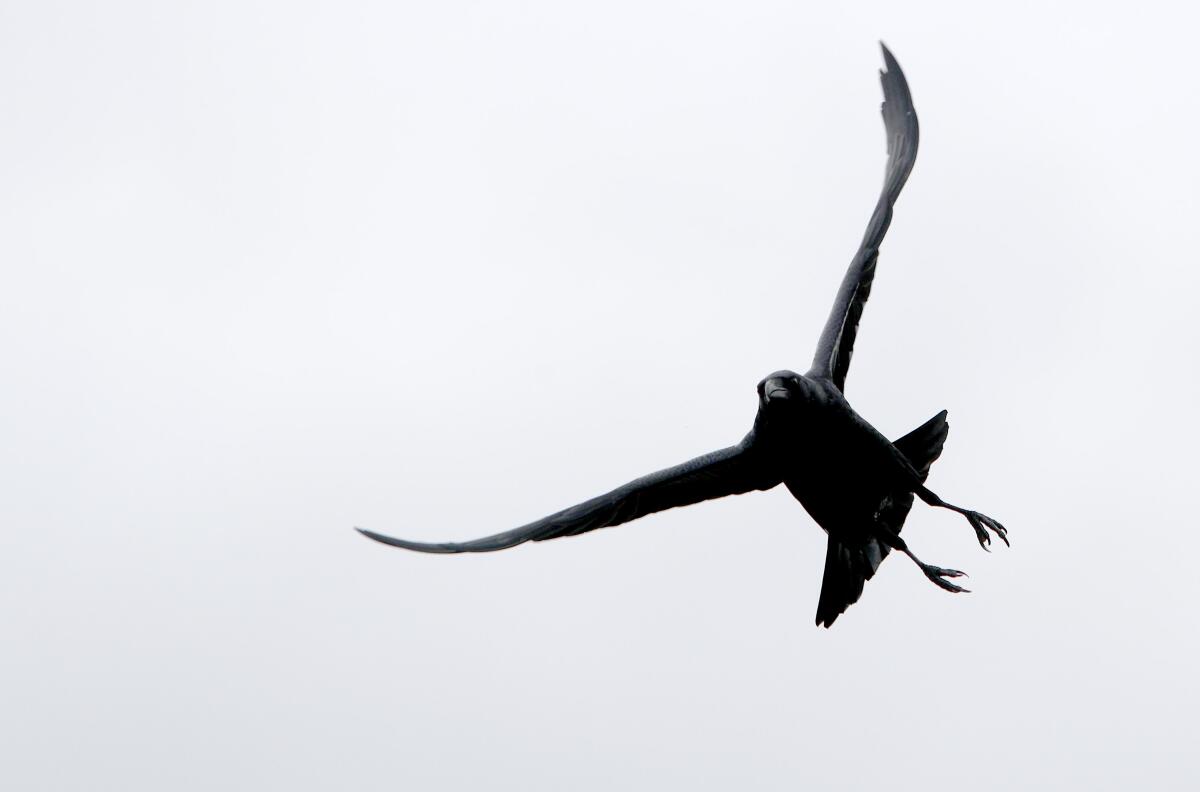
Before Gus and Lisa, there were Bob and Huey.
Bob, a crow, came first, around 1998. He was hit by a car outside the Black Sheep restaurant. Boufford wrapped the bloodied bird in a tablecloth and placed it in a bush to die.
At the end of the night, the crow was still alive, so Boufford took him inside the restaurant. After a couple of days in a cardboard box, Bob squawked. A veterinarian told Boufford that the bird’s crushed wing would never allow him to fly again. So Boufford took him home to an open cage in the backyard.
Bob was ornery.
As an untamed adult, he was not going to reciprocate any human affection. He shrieked. He snapped. But he was protected until he died naturally after about a year.
Two weeks later, the Bouffords were leaving Sunday service at Mariners Church in Irvine when they saw a small, grounded raven in the parking lot, covered in pinfeathers but too young to fly.
Bouffoard scooped up the willing bird and said he would take it to a wildlife hospital. His wife gave him a knowing look.
The bird, named Huey, moved into the backyard cage. Boufford had every intention of saying goodbye to the nestling once his flight instinct kicked in and he returned to the wild.
Knowing what he knows now, Boufford guesses Huey was about 2 weeks old when he found him. He voluntarily stayed six months.
“I’d get up first light and play with him,” Boufford said. If he didn’t, the bird would protest, loudly.
As Huey matured, he perched atop a power pole and scrutinized his surroundings.
“This bird went out of its way to tease everything in the neighborhood,” Boufford said.
A neighbor carried a handkerchief in his shirt pocket. Huey would swoop over his shoulder, swipe the handkerchief and play keep-away with it.
A pair of dogs lunged at Huey when he made a crash landing in their yard. Once he refined his flying skills, he perched on their fence just out of reach and preened while they barked themselves into a lather.
Huey knew the Bouffords’ car and would follow them home from above. Diana is an avid gardener, and Huey would butt into the shower from her watering cans to bathe. He’d swipe nasturtium seeds and store them about the property. They still bloom every spring.
Corvids can mimic human speech, and Huey would sit in a tree and offer extended oratories in a series of warbles, clicks, purrs and a gurgling “hello.”
The conservancy gives Boufford dispensation to rescue birds in the park, though none has lived under his care as long as Huey.

Ravens are mythologized, feared and revered in traditions around the world. They’re portrayed as prudential, mischievous, guardians, loyal spies, scavengers, even omens of death.
To the ancient Greeks, ravens were the god Apollo’s messengers in the mortal world. Shakespeare referred to them in “Hamlet” — “Come, the croaking raven doth bellow for revenge.”
King Charles II is said to have ordered that six ravens be kept at the Tower of London to ward off misfortune. The crown would fall if the captive ravens flew off. A flock remains.
Edgar Allen Poe wrote a famous poem about one. The verses are part of the American literary canon evermore.
Boufford said he tied together the animal and human spirits while gazing at the Back Bay deep in thought and in conversation with God.
He concluded that time builds relationships, and without a common language, humans and animals rely on faith for their trusting but unspoken bonds.
Early Christmas morning 1999, the Bouffords took a small tree into their backyard and held a party with Huey. They gave him a few treats: canned tuna, coins, nasturtium seeds.
A few days later, he was ready to leave. His day trips with the area crows had been getting longer.
Boufford was on his roof adjusting his television antenna in advance of his Rose Bowl watch party. Huey and a few crows landed nearby. Huey looked him in the eye, called and flew away.
Boufford says he still sees a bird that looks a lot like Huey soaring over the Back Bay.
Sometimes he hears a passing “raaawk” over his roof.
Davis writes for Times Community News.
More to Read
Sign up for Essential California
The most important California stories and recommendations in your inbox every morning.
You may occasionally receive promotional content from the Los Angeles Times.

